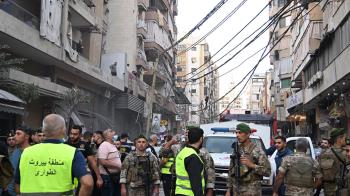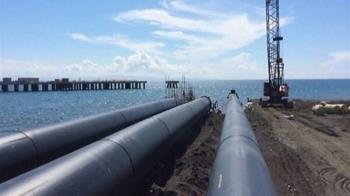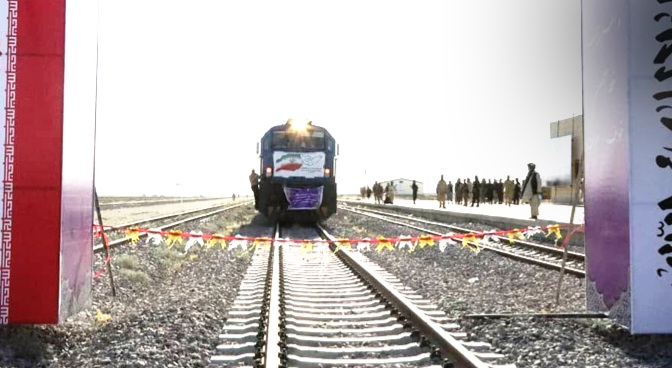Alwaght- Despite their enormous construction costs, railways have significant transportation capabilities. They not only have a quick and considerable impact on the geopolitical and geoeconomic status of countries, but they also extend trade patterns to the international realm of politics and diplomacy. Countries with high capacities in this lucrative area can gain an upper hand in global developments.
Iran has always attached a great importance to broadening its trade ties with neighboring countries through transit routes and since the old times it has been the linking bridge for Silk Road and Europe. So, in recent years, it has worked to restore its past role in the rail corridors, and to this end, it put high on its agenda the expansion of its railway network with Afghanistan and the Central Asian countries.
While the Islamic Republic of Iran still does not recognize the government of the Taliban in Afghanistan and maintains no major diplomatic relations with them, there are also existing differences over Iran's share from Helmand River, which further intensifies the tensions between the two parties. However, despite these challenges, the administration of President Seyyed Ibrahim Raisi is actively pushing to enhance trade and economic cooperation with Kabul.
As part of this agenda, Hassan Kazemi Qomi, Iran's acting ambassador to Afghanistan, on Wednesday met with Afghanistan Railway Authority chief Bakht Al-Rahman Sgherafat. They discussed the existing railway cooperation and the Iranian diplomat asked the Taliban official to visit Iran to discuss grounds for cooperation.
Kazemi Qomi's railway negotiations with the Afghan side came in the context of the recent opening of the Iran-Afghanistan railway route, which extends to Roznak, Herat, in the presence of the CEO of the Afghanistan Railway Authority, the governor of Iran's Khorasan Razavi province and a number of Iranian officials, paving the way for trade relationship boost.
Zabihullah Mujahed, the spokesman to the Taliban government, at the time voiced Kabul’s support for expansion of railway links to Iran and in a tweet said: “The inauguration of the railway between Iran and Afghanistan and the transfer of goods from Turkey to Afghanistan through Herat opened a major trade route between Afghanistan and Europe. After this transfer, Afghanistan's goods will also be transferred through this route, and the plan to transfer passengers through this railway line is on the agenda, too.”
Khaf-Herat railway was on agenda since decades ago to bolster the trade ties between the two countries, but some issues hindered work on it. However, with an Iranian government resolution passed in 2003, the initial stages of the railway started. However, funding and technical problems set up obstacles ahead of its progress for years. Still, in 2020, the work on the project was accelerated and its first and second phases were completed and recently its third phase was opened, and only a step remains to is full operation.
This rail route is 225 kilometers long and its implementation was designed in four sections. The first and second sections are in Iran and the third and fourth sections are in Afghanistan. About 140 kilometers of this railway is located in Iran and 85 kilometers in Afghanistan. Iran paid for three sections and developed them by its engineers at an approximate cost of $50 million, and the completion of the fourth section was assigned to the Afghan side. This railway includes 9 stations, 5 of which are in Iran and 4 in Afghanistan. The construction work of its four sections should have been done simultaneously, but so far, due to Afghanistan funding problems, the south section has not made major progress.
If the Taliban interim government can construct the fourth section, trade between the two countries will gain pace and its costs will go down. This railway has the capacity to transfer 6 million tons of goods and 1 million of passengers annually, reports say.
Afghanistan's commercial benefits of railways
Although the international community has not politically recognized the interim government of the Taliban, Kabul rulers hope to expand their foreign trade by playing a role in communication corridors, especially railways, and enjoy the benefits of regional transit.
If the Khaf-Herat railway is completed, Afghan trains will have access to Iran's rail network, and Afghanistan-made goods will be sent to global markets at a lower cost and with greater security instead of trucks. In addition, Afghanistan will be linked to the Persian Gulf, the Oman Sea, the Caspian Sea and the Indian Ocean ports, which can lead to economic prosperity in this Central Asian country.
Khaf-Herat will not only boost Afghanistan trade with Iran but also help bolster trade with other regional countries.
Herat is a city with a population of 550,000 and has long been a strategic hub of the Silk Road and is responsible for most of Afghanistan's trade with Iran and is one of the richest cities in Afghanistan. Until now, land trade between Iran and Afghanistan was carried out by trucks, but with the opening of these rail lines, the monopoly of road transportation will be broken, and the security of trade will enhance.
According to data, currently, 40 percent of Afghanistan imports are conducted through Dowqarun border crossing in Iranian city of Taybad. Actually, operation of Khaf-Herat railway will cut the number of the 180,000 trucks transporting goods annually to half. This railway not only cuts the transportation costs but also increases the bilateral trade considerably.
According to a major plan underway in the region, Afghanistan rail routes are expected to be connected to others in Iran, Central Asia, and China, and this will double Afghanistan's significance. With expansion of Afghanistan railways and their connection to the Central Asia, inter-regional connections grow even easier. Therefore, this country, if connected to the corridors of Central Asia and China, can make a regional hub for loading and unloading goods to and from China, Central Asia and Iran.
The Khaf-Herat railway will also be connected to Iran's North-South Corridor, a strategic route that is of significance to Afghanistan that is suffering from a special geopolitical restriction. The geopolitical importance of Afghanistan has turned the country unto a scene of political and geopolitical competitions between regional and international powers in recent decades, and the connection of this country to the Oman Sea and the Persian Gulf through Iran will add to its importance and position even more.
Afghanistan has always been dreaming of access to the high seas, and connection to the North-South Corridor will provide this opportunity to the country through Iranian Port of Chabahar. After all, expansion of transit between Iran and Afghanistan will supplement India-Central Asia route, and having in mind that Afghanistan shares hundreds of kilometers of borders with Iran and among the other eastern neighbors exports the largest amount of goods to Iran, it can see a jump in trade with its link to this corridor.
Iran's trade interests
Though Iran has undertaken a large part of costs of Khaf-Herat railway, it will make huge profits from this project. Tehran is eager to create more jobs in western Afghanistan to prevent immigration to its territory. At the same time, the railway projects bring about economic growth to Iranian province of Sistan and Baluchestan, Southern Khorasan, Razavi Khorasan, and Kerman.
With the launch of Khaf-Herat railway, the transportation chain and the connecting point of the North-South Corridor will be completed. This means that transit from Afghanistan to the Persian Gulf, and with the completion of Chabahar-Zahedan-Mashhad, to the Sea of Oman will be possible. Also, Khaf-Herat railway will scale up the Iranian exports to Afghanistan one and a half fold as it cuts the transportation costs.
Iran-Afghanistan annual trade volume is more than $1 billion, and with the completion of this rail project, it will increase in the future and bring economic prosperity in the cities located along this route. Iranian officials believe that if this railway line is properly used, especially in the not-so-distant future when it is connected to international railway network, the border provinces of Iran in the east will become active centers and make bonds for good economic, social and cultural relations with Afghan cities. Therefore, there is a need to develop the railway infrastructure in order to benefit from the emerging atmosphere to strengthen business relations with the outside world.
Iran seeks access to raw minerals like iron ore from Afghanistan's west. With the completion of the rail links, these minerals can be transferred to Iran and can provide huge benefits to the two countries.
Iran is trying to become a regional transportation hub and allow Afghanistan and other landlocked Asian countries to ship goods to Iranian ports, which will help boost trade in Iran. If this railway is developed inside Afghanistan, it will not only connect Iran with Central Asian countries and their rail network, but also pave Iran's way to China.
The Khaf-Herat railway forms part of the $2 billion Five Nations Railway Corridor (FNRC), a project spanning 2,000 kilometers. It originates in Iran, extends through Afghanistan and Tajikistan, and further connects to Kyrgyzstan. From there, the railway continues onward to China's Xinjiang province.
This railway is also part of the New Silk Road project of China, and should this missing railway link is found, East-West trade will further prosper, and countries along this rail route in addition to more proper access will enjoy transit benefits. Iran, as the linking ring of the East and West will play an effective role in the railway-based global trade.
Also, Herat can become the gateway of Iran to Central Asia and vice versa, and Khaf-Herat railway can contribute significantly to the diversification of foreign trade routes for Iranian businesspeople active in Central Asia.
This rail project is a significant success for Iran, and its construction moved forwards despite the US sanctions. The tenacious pursuit of the project helped Iran integrate in the regional economy and impair the effects of the American sanctions. As part of its efforts to neutralize the sanctions, Iran shored up its trade ties with neighbors and railways come to the focus of administration of President Seyyed Ibrahim Raisi more than ever. Tens of agreements inked with Central Asian nations, China and Russia serve this agenda.
Currently, Iran has 6 international rail lines with Turkmenistan, Turkey, Azerbaijan, Pakistan and Afghanistan, and once Iraq and Azerbaijan link projects are concluded, the number will rise to 8, and these routes will contribute to trade boost in the region, and Iran will be the center of gravity of this international trade. In other words, the increase in the volume of trade between Iran and regional countries will also neutralize the US actions to isolate Iran and enhance Iran's weight and position globally.
In general, it can be suggested that transportation communications are a crucial part of Iranian and Afghan strategy to build up their international position after start of Ukraine crisis. Therefore, tentative launch of Khaf-Herat railway will provide Tehran and Kabul with the opportunity to show the world that they are not isolated despite Western adverse efforts against them.
With the completion of this project, this railway will become a key point of the regional transportation network. Still, to realize this outlook and take full advantage of its potentials, Iran and Afghanistan should beat serious challenges and fight rivals in a tough race to not fall behind in trade through railways which play an essential role in today's world.



























